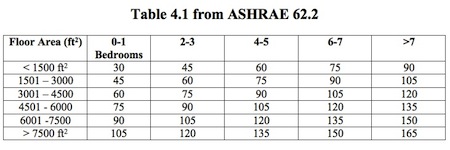Breathe! – Get Fresh Air into Your Home with ASHRAE 62.2

Guest Post. Today’s article is a guest post by Paul Raymer, one of the top guys I know on the topic of getting fresh air into homes.
Guest Post. Today’s article is a guest post by Paul Raymer, one of the top guys I know on the topic of getting fresh air into homes.
Homes are boxes of air that we have carved out from the space on the planet. We capture the air in the box and then we condition it – warm it and cool it and filter it and dehumidify or humidify it – trying to make the space comfortable, healthy and safe for the occupants.
To do all that conditioning we put in what we affectionately call the HVAC (Heating, Ventilating, and Air Conditioning) system. I see trucks driving around proudly proclaiming that they do it all. But when you ask HVAC contractors what they do about ventilating, they avoid the subject. I asked a plumber once how he selected a bathroom fan and he replied, “It depends on what kind of car the owner drives.”
There is a national ventilation standard, developed and supported by ASHRAE (American Society of Heating, Refrigerating, and Air Conditioning Engineers (notice there is no ventilation in that title)). It’s Standard 62.2-2010 for “low rise residential buildings.” Unless things get postponed, as of January 1, 2012 that standard will be part of all the national weatherization programs. But even if it is just a postponement, mechanical ventilation is here to stay, and it is time that programs began to accept the fact that the type of car the owner drives should be a very small part of selecting a residential ventilation system.
Most weatherization programs have been relying on the old standard – ASHRAE Standard 62-1989 – that is no longer supported by ASHRAE. As houses get tighter, getting the right ventilation system will no longer be a casual shrug of the shoulders. Besides which adding a properly designed ventilation system can be another profit center. And it doesn’t have to be all that complicated.
So let’s take on the Standard. First of all you can go to the ASHRAE website and read it or buy your own copy. (Click on the link for the 62.2-2010 Standard near the middle of the page.) It starts out with a statement of its scope and purpose and then lists a bunch of terms that we may come back to in a later blog.
But the first real meat of the Standard is the “Whole-Building Ventilation.” This is primarily a ventilation system that should handle all the air in the building for background ventilation. The simplest way to deal with this is to go to Table 4.1, enter it with the square footage of the building and the number of bedrooms, and select the ventilation rate.

For example a 2 bedroom, 1700 square foot house would need a 60 cfm fan. Bam! How hard could it be? That fan should run all the time. That’s easy. You could hard wire it although you do need to provide the occupant with a way to shut it off. It needs to be a quiet, energy efficient fan so that the occupant won’t be tempted to shut it off. If you get that done, you’re a long way to complying with a fundamental part of ASHRAE 62.2-2010.
The Standard doesn’t prescribe what type of ventilation system is used. It could be exhaust-only (negative pressure in the house with respect to outside), supply-only (positive pressure in the house with respect to outside), or a balanced approach like a heat or energy recovery system. Exhaust-only is the most common in the U.S., relying on the cracks and leaks in the building to allow make-up air to flow back in. Remember, one cubic foot leaving must be matched by one cubic foot coming in.
One other thing to remember is that ASHRAE 62.2-2010 is a national (one standard fits all), MINIMUM ventilation standard, and, in fact, some of us may need more fresh air than others!
About the author: Paul H. Raymer has been working with building science for more than thirty years and is the author of the Residential Ventilation Handbook (McGraw-Hill, 2010). He writes a column in Home Energy Magazine, has multiple certifications, and is a full member of ASHRAE (a voting member of the 62.2 Standard Committee), the IAQ liaison for the Home Ventilating Institute (HVI), and a member of the Society of Building Science Educators (SBSE). You can visit his company website at Heyoka Solutions.
Photo by greencandy8888 from flickr.com, used under a Creative Commons license.
This Post Has 2 Comments
Comments are closed.

As an inspector for a local
As an inspector for a local community action agency’s weatherization program, I have begun implementing ashrae 62.2-2010. One problem we are encountering is this, when installing whole house ventilation in retrofits, often homes have atmospheric hot water tanks. The atmospheric tanks are prone to backdrafting when more negative pressure is added to the home. In my opinion, this needs to be first and foremost in the minds of anyone who will be installing any ventilation in a home. The problem is generally magnified by a house that is already tight from the get-go and we will be tightening it as we perform our weatherization measures. Any installers should be aware of the drafting issues that may be caused by the addition of whole house ventilation and be prepared to take precautions to provide a healthy and safe home to their clients.
Doug – Agreed! That’s why
Doug – Agreed! That’s why worst case CAZ testing is an essential 1st step when evaluating homes with combustion appliances. “Do No Harm”